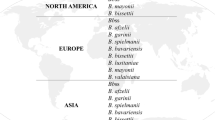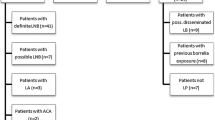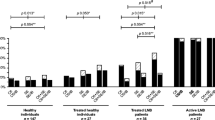Summary
As long as test procedures are not standardized, the serological results of IgM-and IgG-antibodies in Lyme borreliosis must be interpreted with caution and always in the context of clinical signs and symptoms. False negative results occur primarily during the first weeks of infection. In erythema migrans of less than 4 weeks' duration, 50% of patients are seronegative even with newly designed ELISAs. At this early stage of the infection the therapeutic decision has to be established on the basis of clinical criteria. Frequently IgM-and/or IgG-antibodies develop during antibiotic therapy. After 4 weeks' duration 80% of patients have elevated borrelial antibodies detectable with recently developed ELISAs. Positive and borderline results should be confirmed by Western blot. False positive results, particularly slightly elevated IgM, may occur in a variety of other diseases. Another problem is the persistence ofBorrelia-specific IgM antibodies after therapy. Serological follow-up can only be carried out with the same methods in the same laboratory. Retreatment should be considered if IgM antibodies are increasing significantly and new symptoms are occurring.
Zusammenfassung
Solange die Methoden zum serologischen Nachweis von IgG- und IgM-Antikörpern bei Lyme Borreliose nicht standardisiert sind, müssen die Ergebnisse mit Vorsicht interpretiert und stets im Zusammenhang mit der klinischen Symptomatik gesehen werden. Falsch negative Ergebnisse treten vor allem in den ersten Wochen nach Infektion auf. 50% der Patienten mit einem Erythema migrans, das kürzer als 4 Wochen besteht, haben keine nachweisbar erhöhten Borrelienantikörper. Die Entscheidung zur Therapie muß nach klinischen Kriterien gefällt werden. Häufig entwickeln sich IgM- und/oder IgG-Antikörper erst während der antibiotischen Therapie. Nach 4 Wochen sind bei 80% der Patienten erhöhte Antikörper mit den neuentwickelten ELISAs nachweisbar. Positive und grenzwertige Ergebnisse müssen mit dem Westernblot bestätigt werden. Falsch positive Ergebnisse, vor allem geringfügig erhöhte IgM Antikörper, können bei verschiedenen anderen Erkrankungen auftreten. Ein weiteres Problem nach Therapie einer Lyme Borreliose ist die lange Persistenz von borrelienspezifischen Antikörpern. Serologische Verlaufskontrollen können nur mit derselben Methode durchgeführt werden. Eine erneute antibiotische Behandlung ist zu erwägen, wenn IgM-Antikörper ansteigen und neue Symptome auftreten.
Similar content being viewed by others
References
Wilske, B., Preac-Mursic, V. Microbiological Diagnosis of Lyme Borreliosis. In:Weber, K., Burgdorfer, W. (eds): Aspects of Lyme Borreliosis, Springer Verlag, Berlin, Heidelberg 1993, pp. 267–299.
CDC-Recommendations Test performance and interpretation from the Second National Conference on Serologic Diagnosis of Lyme Disease. MMWR Morb. Mortal. Wkly. Rep. 44 (1995) 590.
Engstrom, S. M., Shoop, E., Johnson, R. C. Immunoblot interpretation criteria for serodiagnosis of early Lyme disease. J. Clin. Microbiol. 33 (1993) 419–422.
Dressler, F., Whelan, J. A., Reinhart, B. N., Steere, A. C. Western blotting in the serodiagnosis of Lyme disease. J. Infect. Dis. 167 (1993) 392–400.
Kramer, M. D., Moter, S. E., Hofmann, H., Schaible, U. E., Simon, M. M., Wallich, R. Symptomatik und Diagnostik der Lyme-Borreliose. Dtsch. Med. Wochenschr. 118 (1993) 423–427.
Hofmann, H., Bruckbauer, H. R.: Serodiagnosis of European skin borreliosis and localized scleroderma with different ELISAs and Immunoblots. VII International Congress on Lyme Borreliosis, San Francisco 1996, Abstract No E 824.
Bruckbauer, H. R., Hofmann, H.: Serological follow-up with two ELISA systems after treatment of skin borreliosis. VII International Congress on Lyme Borreliosis, San Francisco 1996, Abstract No E 842.
Sigal, L. H. Anxiety and persistence of Lyme disease. Am. J. Med. 98, Suppl. 4A (1995) 74–78.
Author information
Authors and Affiliations
Rights and permissions
About this article
Cite this article
Hofmann, H. Lyme borreliosis — Problems of serological diagnosis. Infection 24, 470–472 (1996). https://doi.org/10.1007/BF01713052
Issue Date:
DOI: https://doi.org/10.1007/BF01713052




